Five Radeon HD 7970 3 GB Cards, Overclocked And Benchmarked
GeForce GTX 680 cards are nowhere to be found, and the Radeon HD 7970 recently dropped to a much more attractive price. We thought it was time to round up a handful of Tahiti-based cards to see how board partners are improving upon AMD's original recipe.
Five Radeon HD 7970s; One Rises To The Top
When it comes time to buy a new graphics card, don't let a factory overclock become your primary consideration. As we saw in our benchmark results, there's up to a 10% delta separating a reference-class board and the most aggressively-configured model. But then you factor in your own overclocking efforts on each contender and the gap shrinks to somewhere around 5%.
Rather, evaluate each offering as a complete package, factoring in its price tag, its bundle (and how those bundled extras apply to you specifically), noise, heat, and power use. Performance is an important variable, sure, but for most of these air-cooled boards, there's a fairly practical limit where clocks simply won't scale much further.
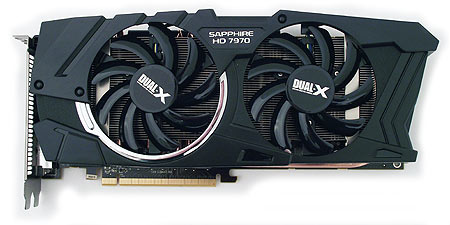
Sapphire HD 7970 OC
Sapphire’s HD 7970 OC includes an impressively quiet cooler, enough adapters to support a trio of DVI-based displays right out of the box, a secondary BIOS switch for easily-toggled performance boosts, and the flexible TriXX overclocking utility (which includes voltage control). Currently selling for $500, it's a compelling model that's $50 more affordable than even the cheapest reference-class cards just one month ago.
The Sapphire board isn't perfect. It monopolizes three expansion slots worth of space due to its oversized aftermarket cooler. So, it could be hard to use two of them in CrossFire, depending on your motherboard. Plus, a two-year warranty represents cut-back coverage compared to competing cards with three-year guarantees.
Nevertheless, this board's pluses far outweigh those minuses, and for enthusiasts with three screens, it represents the strongest showing in today's round-up. The only factor holding us back from giving this board our Recommended Buy award is Nvidia's GeForce GTX 680. Serving up better performance and selling for the same price, it'd be a shoo-in were it not for sporadic availability.
Sapphire's HD 7970 OC was recently available for $460 on Newegg, and we've been told by a company representative may be extended. At that price, this board is a fantastic buy, regardless of the competition. We still can't hand an award out to a temporary price reduction, though.
Get Tom's Hardware's best news and in-depth reviews, straight to your inbox.
Update (May 21, 2012): According to Sapphire, the HD 7970 OC is now permanently priced at $479.99 on Newegg.
Update (June 1, 2012): Shortly after providing assurance that this card would retain a $480 price tag, Newegg jacked it up to $580. If you're interested in this board, Amazon and Tiger Direct offer much better values on it.
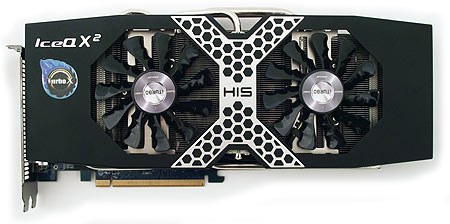
HIS IceQ X2 Turbo and Turbo X
It’s a shame that HIS isn’t bringing its IceQ X2 Turbo X to North America, with its best-in-class 1120 MHz core overclock. But the U.S.-bound 1050 MHz Turbo version (second only to MSI’s 1070 MHz Lightning here in the States) is also appealing.
The IceQ X2 cooler common to both models is extremely quiet under load. HIS’ iTurbo overclocking utility is both simple and effective. Moreover, an MSRP of $500 for the less-aggressive model seems fairly reasonable, though greater availability of GeForce GTX 680s could put some pressure on that price point. The Turbo X is even more expensive (we're told it'll be roughly equivalent to $520 overseas). However, gamers content to leave their clock rates alone will pay a premium for an already-overclocked model purported to be the fastest in its class. HIS' Turbo X was the only card with a GPU we could push past 1200 MHz, yielding a 1250 MHz overclock.
Our concerns about this board include 12" of length (plus the bezel), a two-year warranty that falls short of the vendors offering three years, and a lack of bundled mini-DisplayPort adapters. Enthusiasts building multi-display configurations will incur additional cost if they require DVI connectivity. Finally, because HIS' board is not available, we can't accurately place it amongst the competition.
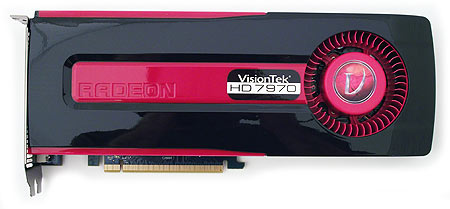
VisionTek Radeon HD 7970
We're impressed by AMD’s Radeon HD 7970 (particularly at a new price point that competes a little more aggressively against GeForce GTX 680). So, it follows that we would like VisionTek’s own offering based on AMD's reference design.
Aside from Sapphire’s card, this is the only board in our round-up that includes enough adapters for triple-display output via DVI connectors, and it conveniently fits into two expansion slot spaces. Available for $480 on Newegg, VisionTek tempts us with the second-lowest cost of entry, the highest stable memory overclock (an astounding 1900 MHz), and the only limited lifetime warranty in the crowd.
This card's biggest liability happens to be its familiar AMD reference cooler, which happens to be louder than any of the aftermarket designs presented in our round-up. When the Radeon HD 7970 first launched, we hoped that AMD's board partners would address the card's disappointing acoustic profile. And they did. But by sticking with that original implementation, VisionTek inherits its unattractive fan ramps and distracting output under load. There are much quieter options available.
Despite our one complaint, gamers shopping for a card with a solid collection of display outputs and adapters, able to fit within the confines of two expansion slots, could enjoy VisionTek's Radeon HD 7970. Particularly at its modest $479 price.
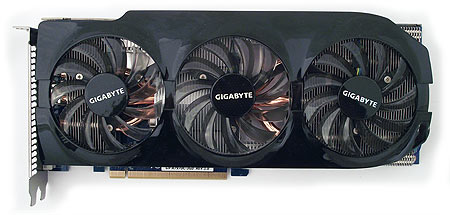
Gigabyte GV-R797OC-3GD
Gigabyte’s card does a solid job all-around, boasting a tuned 1000 MHz core clock and a decent custom cooler. It managed to achieve the second-highest core overclock in our round-up, and it was one of only two cards to breach the 1200 MHz barrier.
Gigabyte offers a three-year warranty on its graphics cards. That's better than the two-year term a number of competing vendors offer.
This product's claim to fame is probably relatively compact dimensions. Measuring only 10.5” long, it’s one and a half inches shorter than the largest card in our round-up, making it an attractive option for people with limited space in their PC case.
The cooler, with its three fans, is a little louder than other options under load though, and when overclocked it produces more noise than any other card we tested. The bundle is missing mini-DisplayPort adapters, too, making the R797OC-3DG less than ideal for a display configuration composed of multiple DVI-based monitors.
With that in mind, the $500 price tag might be a tad steep, particularly if you need to buy a couple of adapters, too. We think that enthusiasts limited by the room in their enclosures (and ready to appreciate this card's short PCB) are the most likely customers for Gigabyte's interpretation of the Radeon HD 7970.
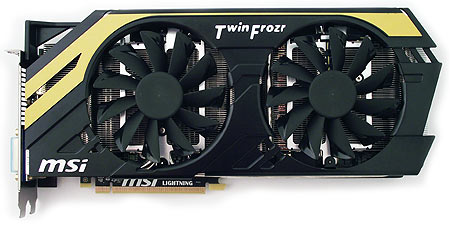
MSI R7970 Lightning
MSI’s Lightning family is, by pedigree, designed to be the very best of the best, enabling great stock performance through tuned clocks, optimized cooling, and beefed-up power. The R7970 Lightning is no exception. It ships with the highest factory core overclock in North America (1070 MHz), a 17-phase voltage regulator, lots of lighting, the most effective and quietest cooler in the pack, purported hooks into the popular Afterburner utility via the second BIOS setting (by far the best overclocking software out there), and adhesion to the United States Department of Defence’s robust MIL-STD-810G standard.
What does that last bit really mean? According the specification itself, "When applied properly, the environmental management and engineering processes described in this standard can be of enormous value in generating confidence in the environmental worthiness and overall durability of materiel system design." No joke. Moreover, the card is backed by a generous three-year warranty.
Priced at $550, MSI's R7970 Lightning pushes the limits of what we’re able to consider value. Though, with Nvidia's GeForce GTX 680 not available in sufficient quantity to give AMD any competition, a premium card like this stands a better chance of success. Unfortunately, the Lightning doesn't seem to be in stock at the time of writing either, making the comparison largely academic.
Our biggest issue with this card is its lack of dual-link DVI support (and consequently a lack of 1920x1200+ resolution and HD3D support over DVI). An active mini-DisplayPort-to-DVI adapter could have addressed this, but MSI doesn't bundle one, which is disappointing. If an adapter was part of the package, we would have a much easier time recommending the Lightning at $550 (a full $50 more than Sapphire's overclocked card, including adapters).
Final Thoughts
When AMD launched its Radeon HD 7970, the company made it clear that board partners were expected to include HDMI-to-DVI and active mini-DisplayPort-to-DVI adapters as standard equipment. We’re bummed to see that a majority of Radeon HD 7970 submitted to us don't include those important components. After all, we believe that every one of these cards should enable easy access to Eyefinity through a trio of common DVI outputs (at least until DisplayPort becomes more prevalent).
Be aware also that the graphics market is currently very volatile. Radeon HD 7970 is settling in to a more ideal price point now that GeForce GTX 680 is known (we hesitate to use the word available, since it's almost impossible to find). Keep a close eye on each one of these cards; prices continue to shift around in the face of GeForce GTX 680, and we expect that behavior to continue until it's more broadly available.
Current page: Five Radeon HD 7970s; One Rises To The Top
Prev Page Power, Temperature, And NoiseDon Woligroski was a former senior hardware editor for Tom's Hardware. He has covered a wide range of PC hardware topics, including CPUs, GPUs, system building, and emerging technologies.
-
aznshinobi I need a new pair of pants. Definitely graphics card eye candy. Specially the Sapphire one IMO. Do I hear giveaway THG?Reply -
schnitter I need to replace my 5870 HD I bought over 3 years ago. I can still play any game on HIGH at 1080p, but I want ULTRA on BF3 and Max Payne 3.Reply
Lets hope the 680 GTX becomes available to see what price these AMD cards end up at. I like AMD and how they don't rebrand their cards like nVidia, but $20 cheaper than 680 GTX is not cheap enough to sway me that way. -
hellfire24 why a reference card(visiontek 7970) with non reference competitors?Reply
i am impressed with HIS IceQ X2 Turbo X but still MSi lightning is my favorite.they have beefier VRMs,great cooling and are overclocking beasts.
-
confish21 Nice write up! Really helps when trying to peg down a card. Will be revisiting alot!Reply -
blazorthon nekromobovisiontek for "Particularly at its modest $279 price." $379 or $479??Reply
$479.99 (USD) is more or less the cheapest price point for any Radeon 7970. -
weatherdude Cool review. It'd be nice if SI units were included in the weights and lengths though. Guess I'll have to do a little math. It's very nice to know that the non-reference coolers are much quieter (excluding Gigabyte's) than the original design.Reply
Let's see some typos:
In the 'Test System Setup And Benchmarks' page in the Operating System row it is written as Microsoft Windows 7 x6. I assume it's supposed to be x64.
In the first paragraph of the 'Sapphire HD 7970 OC' page the card is described as "HD 7970 PC".